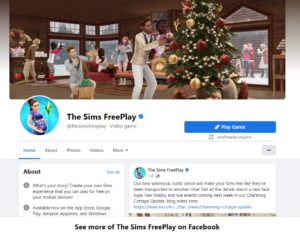Audiences:
Predominately female – colour scheme emphasises femininity and all the relationship scenes make the audience positioned to respond with the female (OTS camera shots)
The female characters are shown first in the customisation
Aged 10-40+
Broad target audience
77% of women surveyed in 35-54 age group said they played games to “help them relax”. For women aged 55-64, games provided “mental stimulation”. These motivations are examples of diversion because they are using the games to escape the stresses and strains of the real world.
The Sims FreePlay is rated 12 because it “may contain themes that are not suitable for younger children, such as the potential for violent fist fights
Industries:
Released in 2011 by EA mobile (Nick Balaban, Michael Rubin) and still available on iOS and Android devices, this virtual town and story builder is free to play, but users are able to purchase in-game items with real money to speed up progress or unlock additional features
David Hesmondhalgh argued companies involved in the cultural industries, such as EA, were just like any other business who wanted to minimise risk and maximise profit. The Sims FreePlay follows the freemium business model – a strategy commonly used in the media industry to attract users to try the product or service.
Representation:
David Gauntlett argues the media and technology play a significant role in shaping our identities and provide us with new ways to express ourselves and connect with others. For instance, the choice of skin tones available at the start of The Sims FreePlay is a recognition of the racial diversity of the audience. Although the gender options follow the simple binary of male and female, players can reject traditional gender roles when they explore the virtual world
Uses and gratifications- 55% of women in the 18-34 age group said “games help them stay connected with friends and family”. This obviously reinforces the argument audiences consume media to develop their personal relationships or, according to Maslow’s hierarchy of needs, their sense of social belonging. Competing against friends in The Sims FreePlay might also improve the player’s self-esteem because they will feel accepted by their social circle.
Sims construct and function stereotypes to generalise their audience.
It has optimistic views of the world and claims realism.
Audience response to representation and issues around identity.
Audience pleasures:
A younger audience can do things in the game that they can’t do in real life (clubbing, relationships, etc)
Making a character how you want
Forming a perfect lifestyle – personal identity and relationships
Aspiration, diversion and escapism
‘Choose every aspect of your Sims lives: careers, appearance, personality and more! Then, watch as their stories unfold! Love and romance, or drama and breakups – the choice is always yours.’
Language:
The narrative is driven through various quests in which the gamer would have to complete throughout the life. There are also a completion of having a successful life which could motivate the gamer to carry on playing.
Sims Freeplay provides a useful case study for the discussion of Baudrillard’s concept of simulacra and hyperreality.
Codes and conventions are used in this video game to influence meaning






